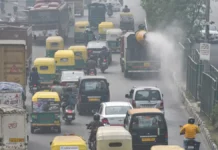NEW DELHI: India is set to increase its public health spending to 2.5 per cent of its GDP by 2025, Prime Minister Narendra Modi said here as he asserted that women, children and youth will continue to remain at the heart of every policy, program and initiative of the government.
Addressing the 2018 Partners’ Forum here, Modi said the high out-of-pocket expenditure incurred by families to avail medical care in India worried his government and to address the issue, it launched the Ayushman Bharat Yojana, which has a two-fold strategy.
The Pradhan Mantri Jan Arogya Yojana provides cashless health insurance cover up to Rs 5 lakh per family per year, covering 500 million poor citizens.
“This number is almost equal to the population of Canada, Mexico and the US taken together. We have already provided free treatment worth Rs 700 crore to 5 lakh families under this scheme within 10 weeks of its launch,” Modi said.
The other arm of Ayushman Bharat, Modi said, is the provision of providing comprehensive primary care at a facility near the community, for which the Centre will start 1.5 lakh health and wellness centers by 2022.
The community will also be able to receive free screening and care for common diseases including hyper-tension, diabetes and three common cancers – of breast, cervix and oral. The patients will receive free medicines and diagnostic support close to their homes, he said.
At the event, Modi said the government is set to increase its spending on public health to 2.5 per cent of the gross domestic product (GDP).
As of now, the country spends 1.15 per cent of the GDP on health. “This will mean an actual increase of 345 per cent over the current share, in just eight years. We will continue to work for the betterment of people. Women, children and youth will continue to remain at the heart of every policy, program or initiative,” he said.
Modi informed that India’s immunization program, “Mission Indradhanush”, will be featured as a success story, among 12 others from all over the world, in the two-day forum.
Under “Mission Indradhanush”, he said the government reached 32.8 million children and 8.4 million pregnant women over the last three years while the number of vaccines has been increased from 7 to 12.
“On Global Universal Health Coverage Day, I again state that we will continue to work towards pr oviding universal health coverage to all,” he said.
oviding universal health coverage to all,” he said.
He said India’s story was one of “hope. Hope that roadblocks can be overcome. Hope that behavioral change can be ensured. Hope that rapid progress can be achieved”.
The prime minister said that India was one of the first countries to advocate focused attention on adolescence and implement an extensive health promotion and prevention program for adolescents.
“Our effort ensured that they get their due recognition in the Global Strategy for Women’s, Children’s and Adolescents’ Health adopted in 2015,” he mentioned.
Modi said when his government assumed office in 2014, “India was losing more than 44,000 mothers”. The Centre then launched the Pradhan Mantri Surakshit Matritva Abhiyan as part of which doctors pledged one day of service per month to this campaign and 16 million ante-natal care check-ups were performed.
“The country has 25 million newborns. Our robust facility-based newborn care system, which provides care to more than 1 million babies through 794 state-of-the-art special newborn care units, has served as a successful model. As a result of our interventions, 840 additional lives of children under five are being saved each day in India as compared to four years ago,” he said.
Modi said that to deal with the issue of malnutrition among children, the government has launched POSHAN Abhiyan and is also implementing Rashtriya Bal Swasthya Karyakram, which has provided 800 million health screening check-ups and free referral treatment to 20 million children in the last four years.
“Some states and districts have performed at par with developed countries. Others have their work cut out. I instructed my officials to identify 117 ‘aspirational districts. Each such district has been entrusted to a team that works across sectors like education, water and sanitation, rural development with top-most priority to health and nutrition,” he said.
About the government’s work in the women health sector, Modi said more than half of Indian women did not have access to clean fuel for cooking till 2015. The Ujjwala Yojana provided cleaner cooking options to 58 million women.
He said that the sanitation coverage in rural areas has increased from 39 to 95 pc in the last four years after the launch of the Swachh Bharat Mission which aims to make India open defecation free by 2019.
“We all know the saying: If you educate a man, you educate an individual; but if you educate a woman you educate an entire family. We have translated that into Beti Bachao Beti Padhao, a program that focuses on the girl child and on giving her the best quality of life and education.
“In addition, the government has devised a small deposit savings scheme for girls called Sukanya Samriddhi Yojana. With more than 12.6 million accounts opened, this scheme is helping secure the future of the girl child,” he said.
Modi said that the Pradhan Mantri Matru Vandana Yojana is expected to benefit more than 50 million pregnant women and lactating mothers.
He also talked about increasing the maternity leave to 26 weeks, from the 12 weeks earlier, as a significant step towards improving women’s health. PTI






